Blog Archives
Amazing wrap-around spider
When I approached my car the other day, I saw a patch of something on the door handle. “Bird dropping,” I thought, and was about to wipe it off. Then I noticed that the blotch was symmetrical. Uh oh. I looked more closely. A spider, and a real cutie. I’d have been devastated if I’d hurt it.
This is what it looks like when zoomed in on my camera:

The spider has wrapped itself around the door handle, to be as flat and inconspicuous as possible. The photo above shows the body of the spider. Its head is below, mostly hidden from view. The colours and patterns on the body are amazing. I think they’re enhanced because it had been raining and the spider was wet.
Here’s a picture with my hand and the keyhole, for scale:

I took the above photo the day after the first one. Yes, the spider was still there. It was dry this time, and therefore less colourful. And it had moved from the top to the bottom of the door handle.
Here’s the spider’s face, viewed from underneath the door handle:
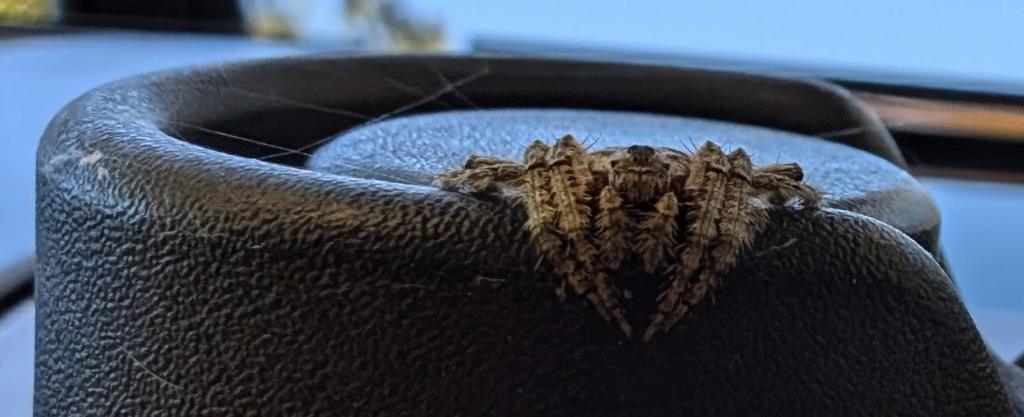
And here’s as much of the head and body as I could get into one shot:

Wrap-around spiders (genus Dolophones) have a flat, curved abdomen, so that they can wrap themselves around branches. This makes them good at disappearing into their surrounds. They build an orb web every evening, and destroy it each morning. I guess those strands of web on the door handle are the remains of last night’s web.
Since the spider had been on the door handle for two days, it looked like it had taken up residence. I don’t think spiders and door handles are a good match, so I persuaded the spider onto a leaf and moved it into the nearby shrubbery:

Water Dragon lurking under water (mostly)
Australian Water Dragons (Intellagama lesueurii) are large dragon lizards, reaching a length of more than two metres. You’ll often spot them close to creeks and other bodies of water (hence the name, Water Dragon). Sometimes, you’ll see them actually in the water:
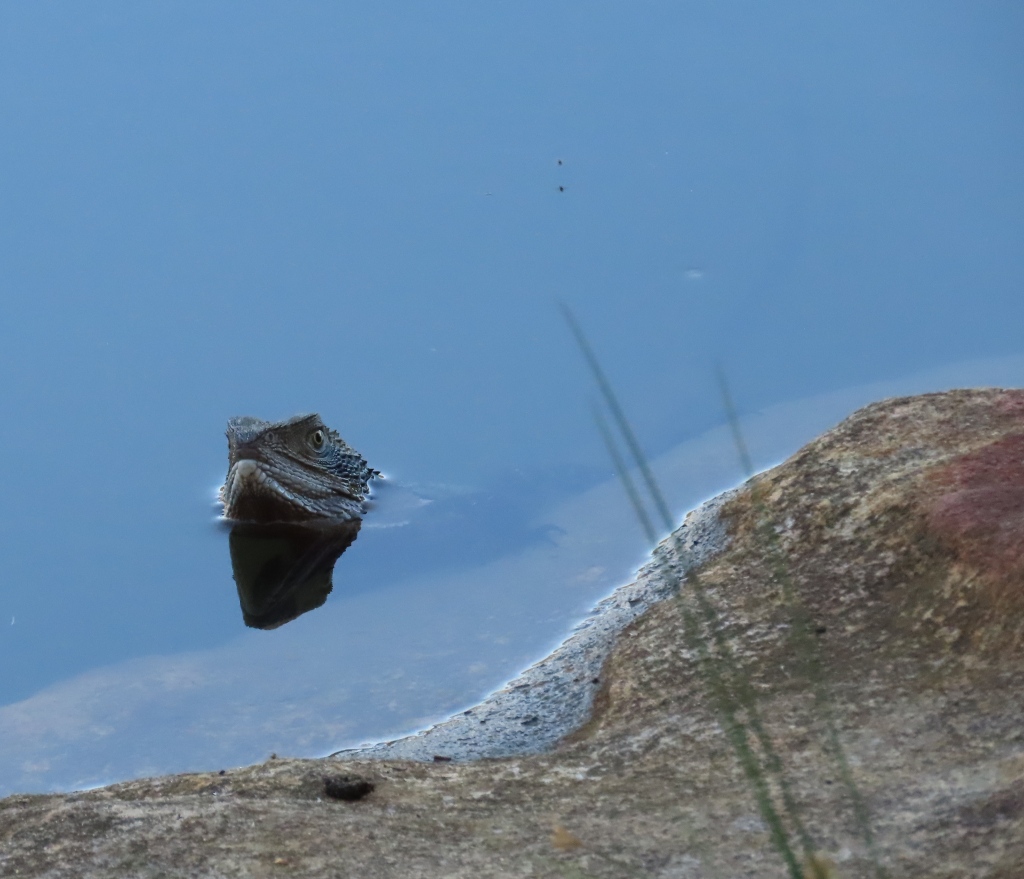
They can stay under water for an hour before coming up to breathe! From a distance, their heads are easy to mistake for a piece of log sticking up. As you draw closer, the rest of the body becomes clearer. This is a different dragon in a nearby spot:

They’re completely at home on the land too. When you approach them, they tend to stay still, pretending to be a tree stump, until you get too close.

Water Dragons eat insects, fruit, and flowers.
A few days ago, I came across a Water Dragon that had spotted a piece of litter (a wet tissue or picnic wipe) and was nosing it when I came along. The video shows the dragon’s characteristic side-to-side gait as it moves away from the litter. (I picked up the litter and took it away.)
Mother wallaby with baby in pouch
Swamp Wallabies are a type of small kangaroo (macropod) found in eastern Australia. I see them relatively often when I’m out walking through the bushland areas in the early morning. Recently, the number of wallabies in my area of Sydney seems to have grown: at any rate, I see them more often I did than a few years ago.
This morning, I saw this mother at Manly Dam park, with a little one in her pouch:
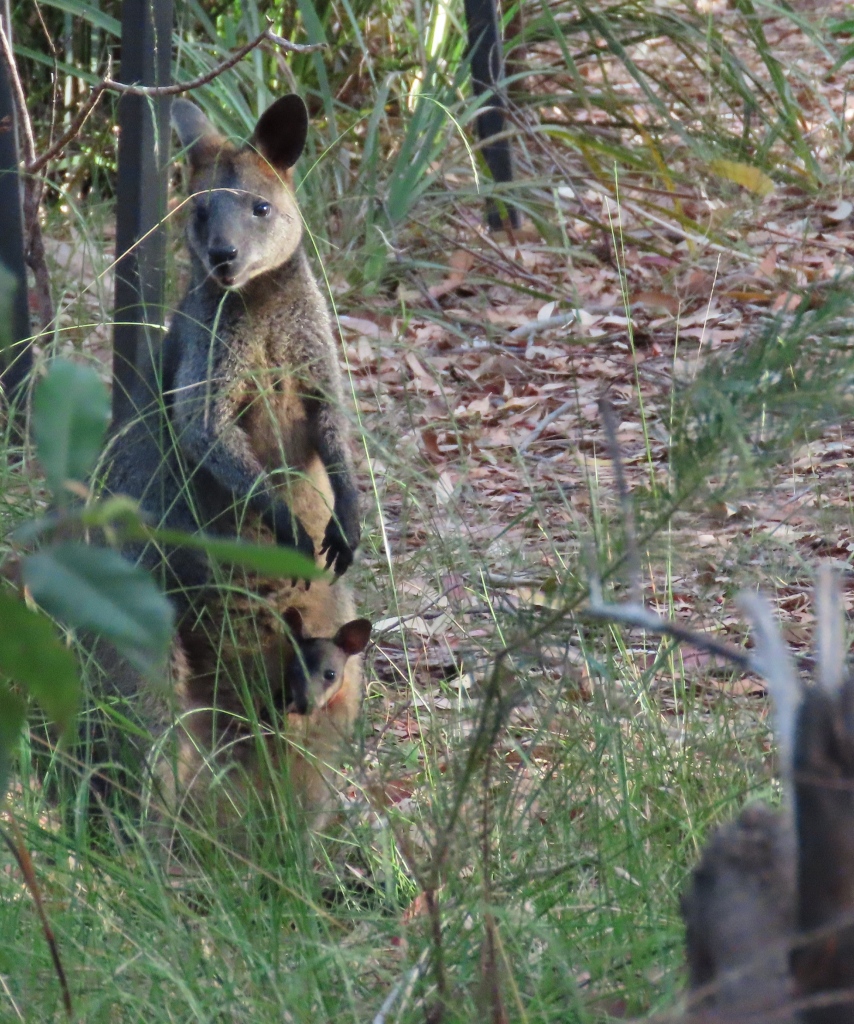
Swamp Wallabies are also called Black Wallabies. They’re relatively small, reaching up to my chest when they stand on their haunches. Their colour ranges from very dark grey to a lighter grey, with reddish patches around the ears and on the underbelly.
They’re marsupials. The little one, called a joey, stays in the pouch for around eight months, until it can live independently. In the picture above, you can see its head peeking out of the pouch.
In the next picture, the joey was withdrawing into the pouch. Only one ear and part of its face are visible:
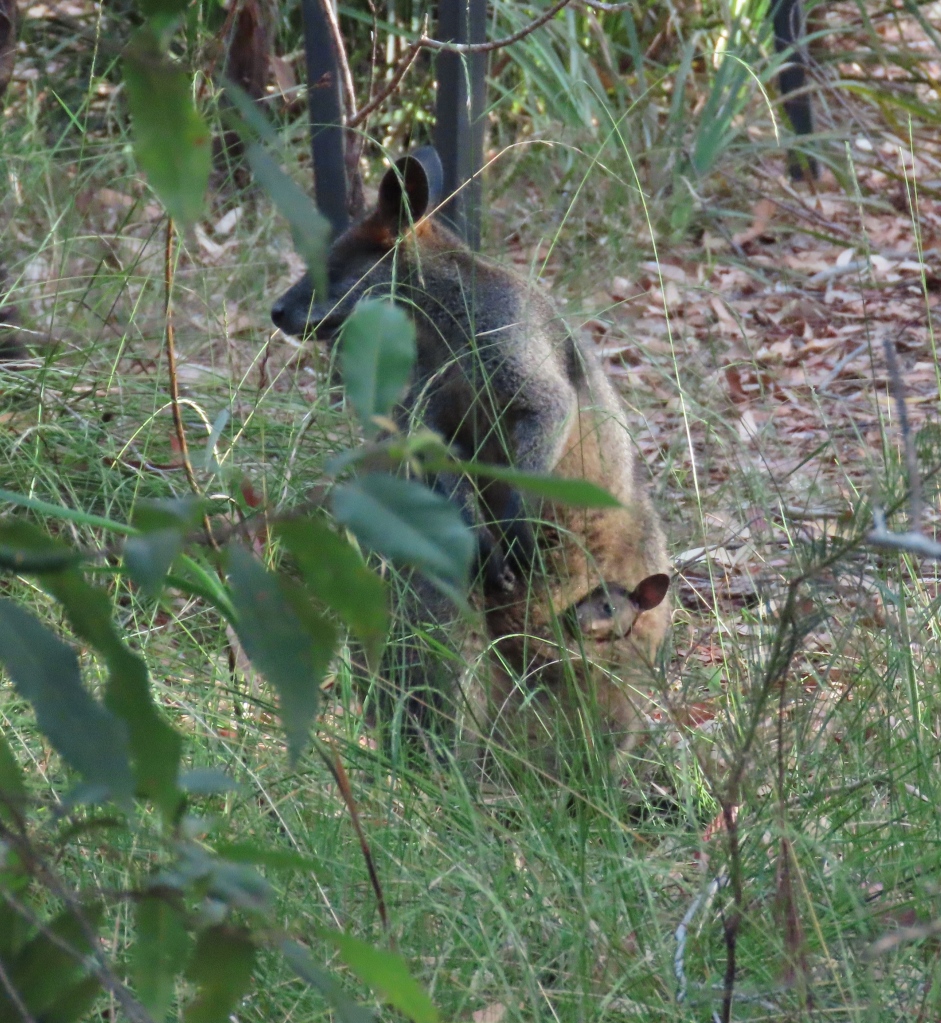
Here’s a short video showing the mother moving around and eating leaves while the youngster looks out at the world:
Generally, wallabies are quite timid and will move away when you approach them along a path. A few days ago, though, I came across one individual who squared up to me and held his ground. This was in a different area of Sydney, on a harbour walk near Balgowlah. The path passed within four metres of the wallaby. It’s breeding season at the moment, and I was probably getting a little close for comfort. I certainly felt a little uncomfortable too, as the animal rose up, turned to face me, and swished its strong tail through the undergrowth to get purchase for a potential fight:
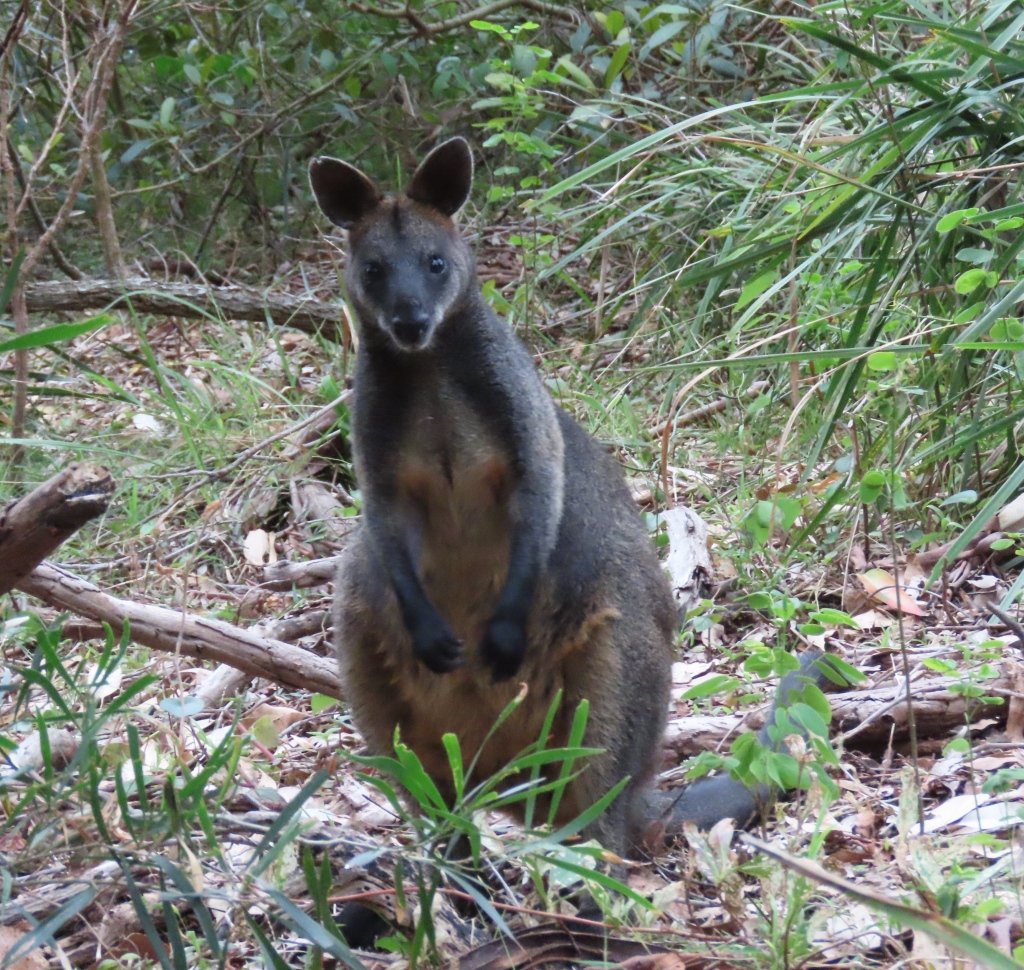
Possums in the day time
A couple of days ago, when walking along a coastal path near Sydney, I saw a dark shape at the top of a bare tree:
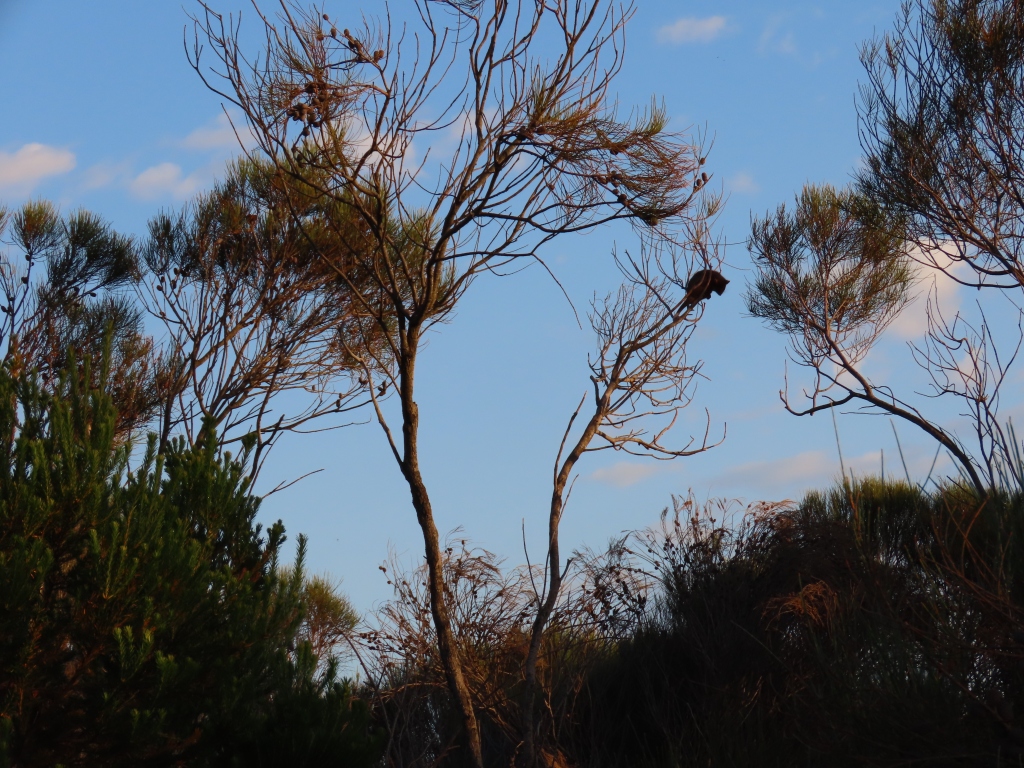
It’s very unusual to see possums out in the daylight. They’re usually active in the dusk and twilight hours. When the sun comes out, they’re tucked into their nests asleep.
This possum was very still. I watched it for about 10 minutes and it didn’t move an inch. I wondered whether it was dead. Perhaps it had been killed by an owl and left there while the bird went on an errand? Then, in a tree close by, I saw two more possums:
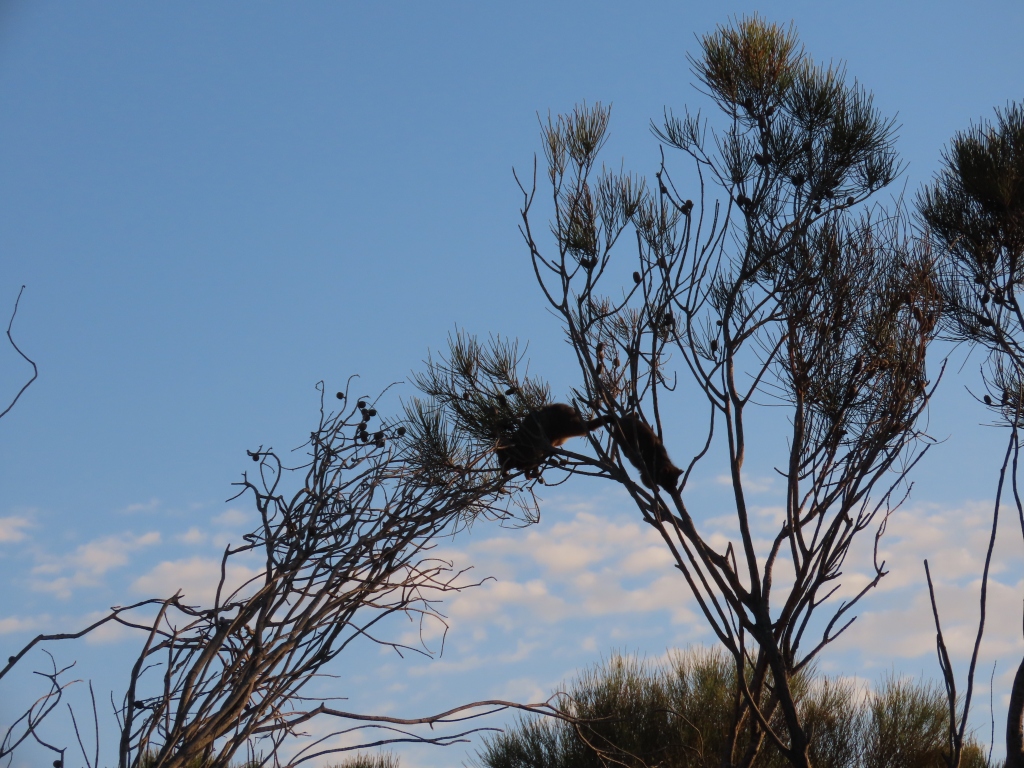
These two were similarly unmoving. No owl would kill three possums, so I felt a stirring of hope. Perhaps the animals were living up to their name and playing possum?
At last, one of the possums came to life:
These are Eastern Ringtail Possums. They’re about the size of a cat, and spend most of their time in trees. You can sometimes see them making their way along the phone lines in the early morning or evening. Their food consists mainly of leaves, fruit, and flowers. They build nests, called dreys, made out of twigs and bark. I’ve seen a couple of these nests, with the little animals inside. The nests are a bit messy, and are large compared to most bird nests.
I hope all three got back to their nests safely, before they could be found by the birds or cooked by the sun!
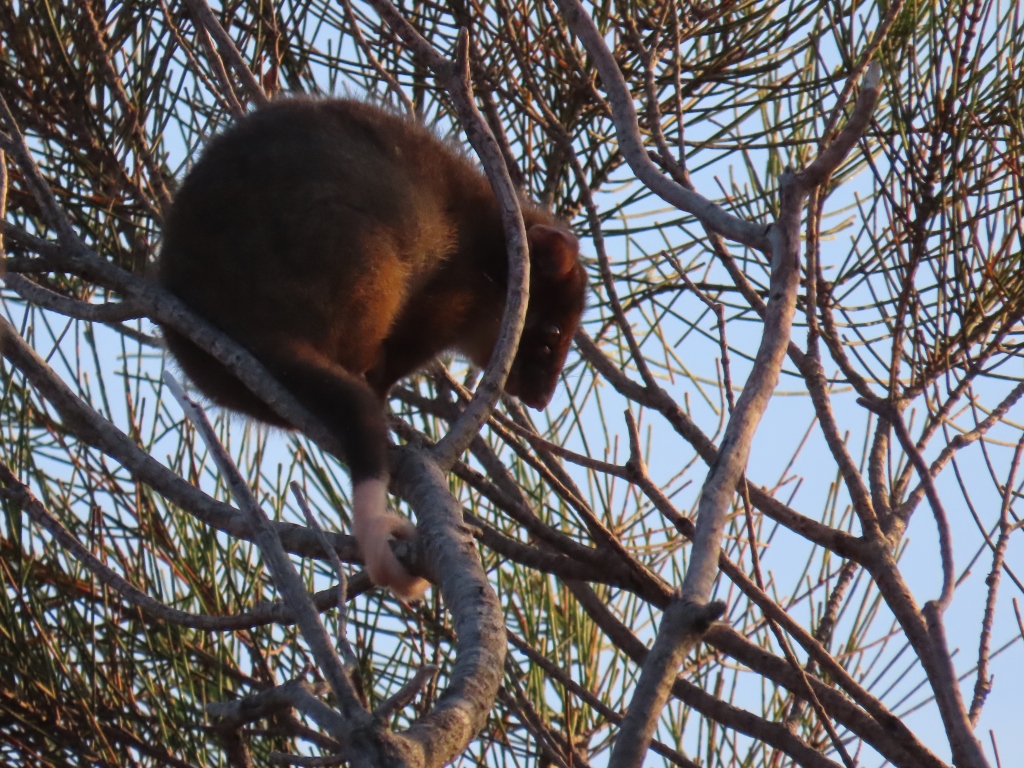
Common name: Eastern Ringtail Possum
Scientific name: Pseudocheirus peregrinus
Approximate length: 35 cm body plus another 30-35 cm tail
Date spotted: 24 December 2022 (summer)
Location: Dobroyd Head, Sydney Harbour, New South Wales, Australia: 33°48’36.6″S 151°16’21.2″E
Moody pics of Huntsman spider on my bannister
Early one morning a few weeks ago, I encountered a huntsman spider on the bannister of a staircase inside my house. I was coming up the stairs from below, and was moving my hand along the top of the railing as I went. Then my head came level with the railing, and there was the spider at eye level.
First wildlife close encounter of the day, and I hadn’t even been outside yet! Life in Oz. 🙂
This is a big spider, about the size of the palm of my hand.
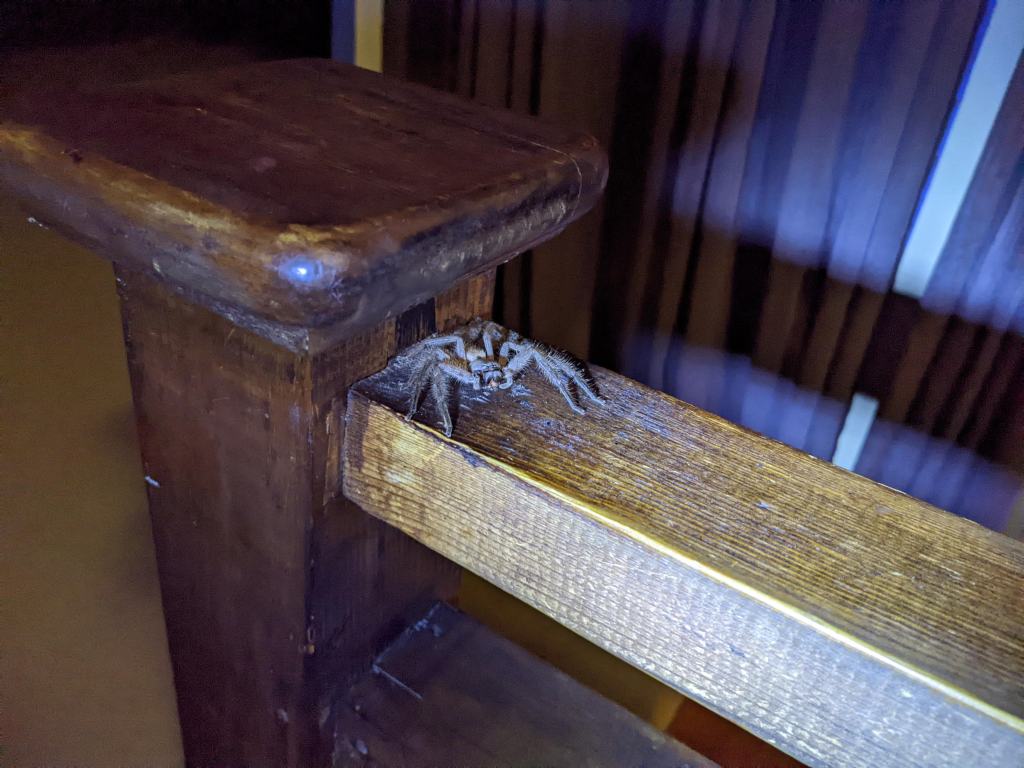
It looked as surprised as I was!
It was still dark and the lighting in this area of the house isn’t bright. I didn’t like using the flash on my phone too much, in case it damaged the spider’s eyes, so I found a torch. Hence the bluesy tone of this next photo:
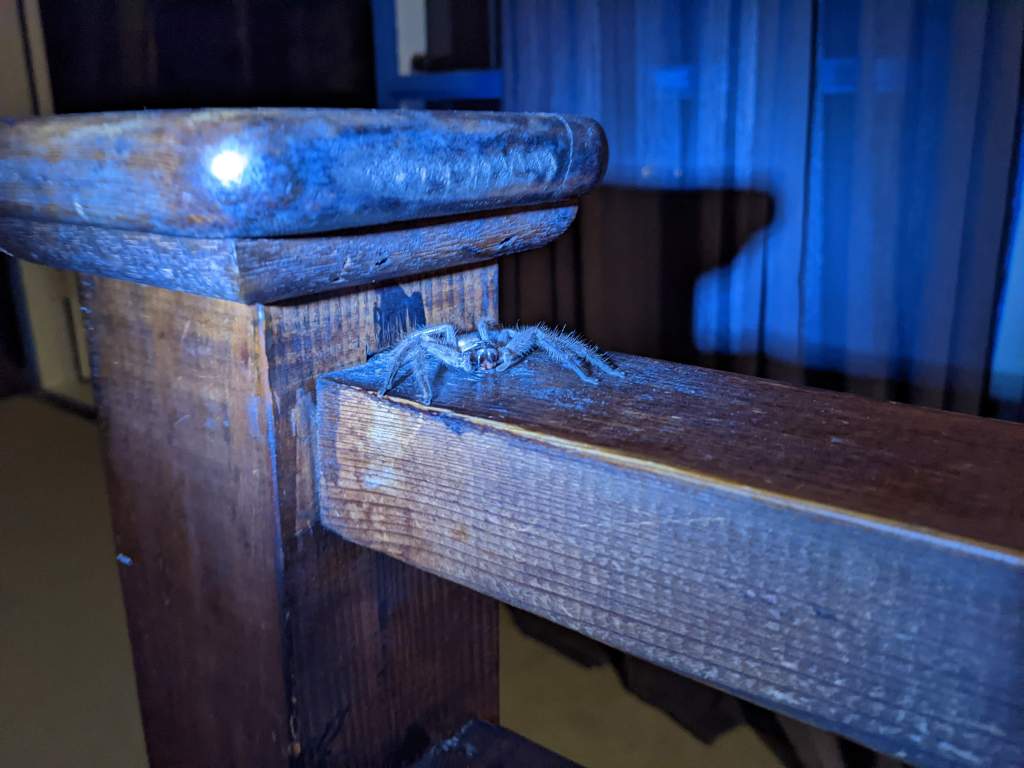
Huntsman spiders are big and scary, but they avoid contact with people if they can, and their venom isn’t too bad if they do bite. They won’t kill you, like some of the other Australian spiders.
Huntsmen generally run away from humans. They don’t go out of their way to bite unless actively threatened. This one might have had good reason to feel threatened by my hand coming towards it along the bannister, though!
And though we see them fairly often and I know they always run away, I do admit to uttering a restrained (not so much) gasp when I saw this one at eye level.
I was heading out for a walk, so I left the spider there, on the bannister, with a scribbled note next to it saying “spider” and an eloquent arrow, so that my husband wouldn’t have the same close encounter that I did.
When I came back, the spider had gone and my husband hadn’t seen it. Who knows where it is now? I’m sure I’ll see it again some early morning!
Bugs: Yellow, orange, and black stripes
A couple of days ago, I saw a pretty bug on the window of my car. It was long, and striped with yellow, orange, and black. It had long feelers which it waved around, and large feet.
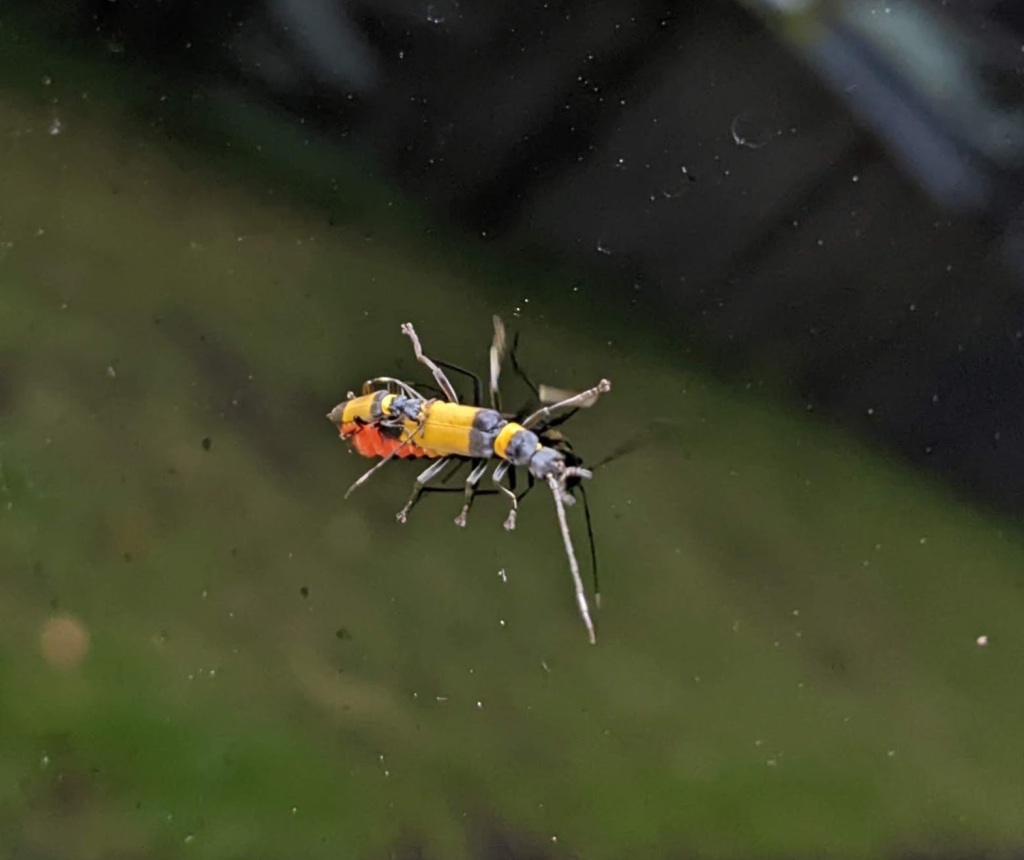
On looking closer, I noticed that it’s not one but two bugs. There’s a small bug on top of the larger one. I’m guessing the smaller one is a male and that they’re mating. Or maybe it’s a baby bug hitching a ride on an adult? Here they are again, from a slightly different angle:

Does anyone know anything about these bugs? I saw them on Sydney’s Northern beaches in late spring.
Update on 30 November 2021: It’s an Imperial Soldier Beetle (Chauliognathus imperialis). Sightings of this beetle seem to be quite rare. Thank you to Hamish Robertson for the identification. And indeed, the smaller beetle is the male, the larger is the female.
Pretty Pardalote on a Banksia bush
Pardalotes are tiny birds that manage to pack a lot of prettiness into sleek bundle. A couple of days ago I saw one foraging in a Banksia bush. It was probably picking tiny bugs (psyllids) from the leaves, or it could be drinking. I noticed in the photo that there are droplets of water on the twig near the bird’s feet:

A view from the top shows the spots on the bird’s head. It also demonstrates how nicely camouflaged the bird is in its natural environment:

Common name: Spotted Pardalote
Scientific name: Pardalotus punctatus
Approximate length: 10 cm
Date spotted: 25 May 2021 (late autumn)
Location: Manly Dam Park, New South Wales, Australia: 33°46’47.3″S 151°15’02.2″E
Spangled Drongo near Sydney
“Drongo”. What a weird name for a bird. Add “Spangled” and it sounds as if you’re about to encounter a clown. I’ve only spotted a Spangled Drongo once before, and that was up in Queensland. A few days ago, while walking in the bush near Sydney, I heard an unusual sound. A deep, slow chattering. The bird in question was perched high on a dead tree:
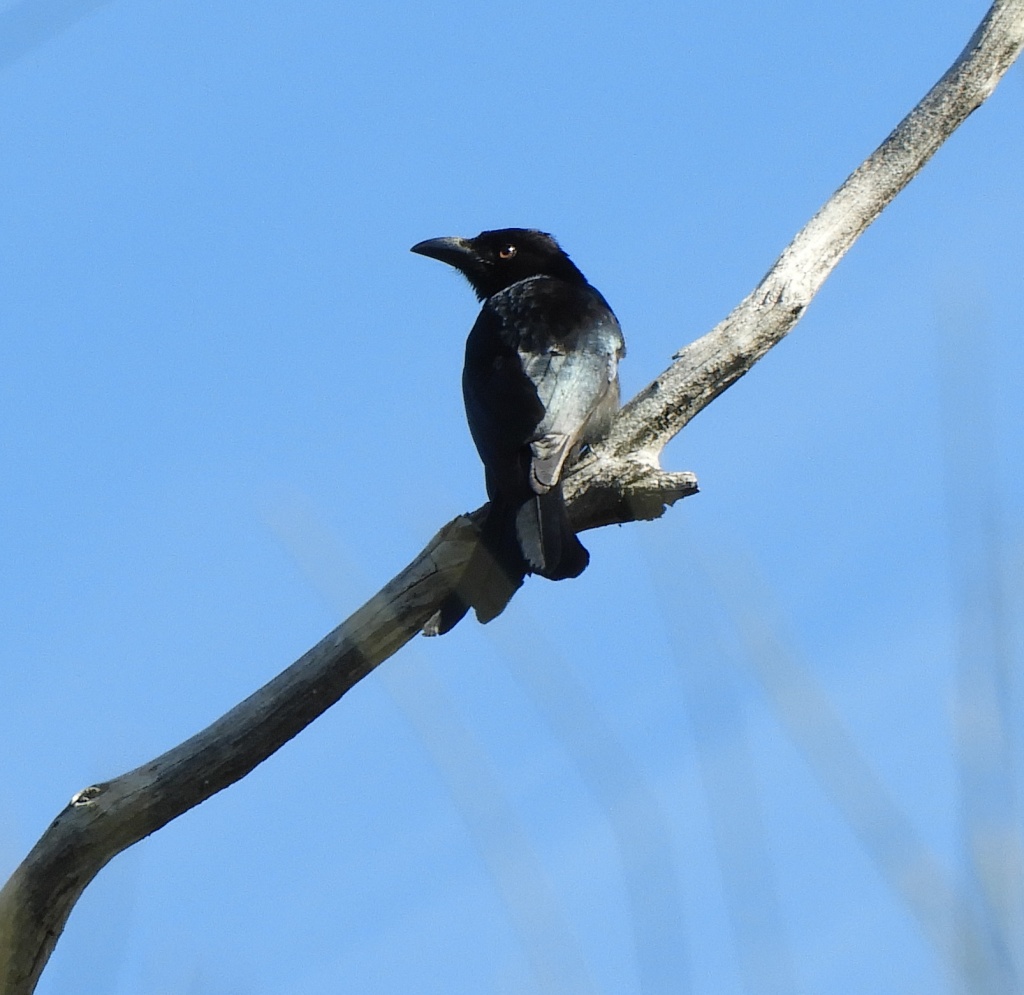
Just look at that forked tail, strong beak, and keen eye. An unusual bird indeed, and quite large at 30 centimetres or more from head to tail.
In Australia if someone calls you a “drongo”, it’s a bit of an insult. It means they think you’re not all that bright.
Common name: Spangled Drongo
Scientific name: Dicrurus bracteatus
Approximate length: 30 cm
Date spotted: 25 May 2021 (autumn)
Location: Manly Dam Park, New South Wales, Australia: 33°47’02.2″S 151°15’16.2″E
Eastern Whipbird chirrups to itself
While foraging and exploring the forest floor, this Eastern Whipbird chattered companionably to itself:
It’s likely that the bird’s partner was nearby. I’ve heard whipbirds chirruping and calling to each other on other occasions too. As well as this quiet chirruping, whipbirds make a long, drawn-out whistle ending in a short explosion. That’s the sound that gives the birds their name. You can hear that call in another post of mine.
Common name: Eastern Whipbird
Scientific name: Psophodes olivaceus
Approximate length: 30 cm
Date spotted: 19 May 2021 (autumn)
Location: Manly Dam Park, New South Wales, Australia: 33°46’48.0″S 151°14’53.6″E
Diamond Python in Banksia tree
A couple of days ago, when walking along a bush bath in the Manly Dam park, I met a man carrying an empty cloth bag attached to a stick. I said hallo, received a friendly greeting in return, then asked him what he was capturing. He said, “Releasing, not capturing.”
“OK, what are you releasing?” said I.
“A Diamond Python.” When I responded with a delighted smile rather than a fearful gasp, he said, “Would you like to see it?” He led me down a path and pointed to the snake, which was making its way happily up a Heath Banksia tree.
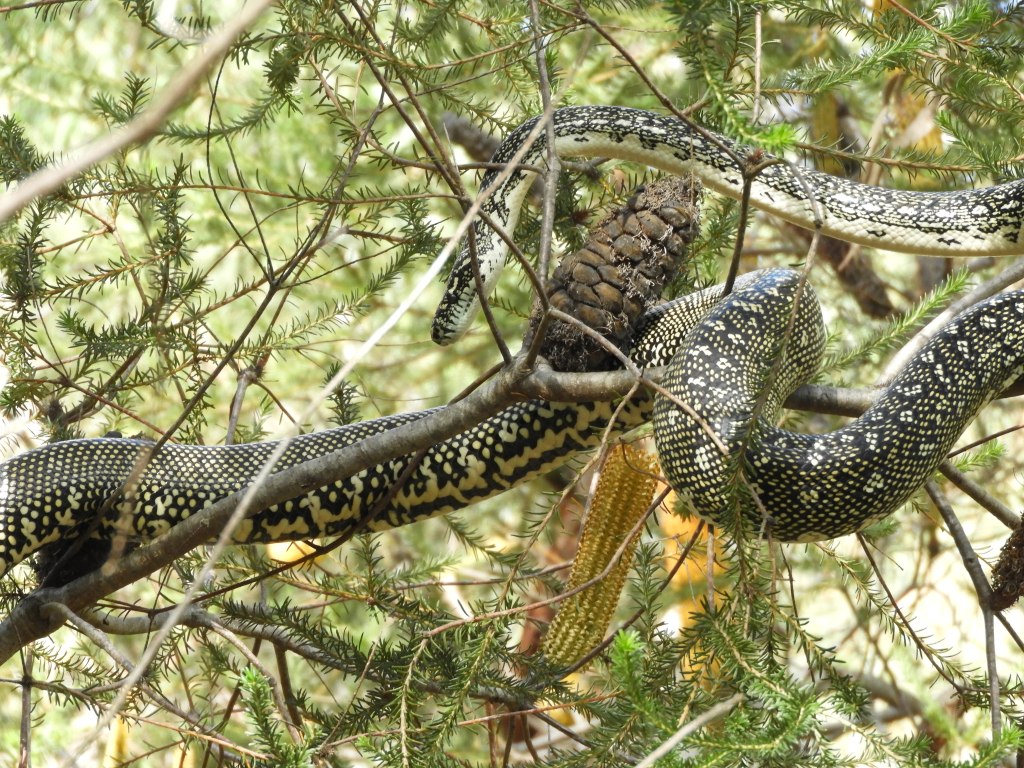
The markings on the snake’s skin are amazingly intricate. And such a gorgeous face:

The snake catcher said that the snake had been found on the roof of someone’s car in a nearby suburb. He’d been called to remove the snake, and Manly Dam park is a great place to release creatures like this.
Diamond Pythons are related to Carpet Pythons, and are native to the eastern coast of Australia (which is where I am). They’re the most southerly occurring python in the world. This one was about two metres long, I think. They can grow up to three metres.
Here’s a short video showing the snake’s lazy movement as it slides along the branches of the Heath Banksia tree:
Thank you to Chris Zabriskie for the video soundtrack:
What True Self, Feels Bogus, Let’s Watch Jason X by Chris Zabriskie is licensed under a Creative Commons Attribution 4.0 license. https://creativecommons.org/licenses/by/4.0/
Source: http://chriszabriskie.com/reappear/
Artist: http://chriszabriskie.com/
What about the birds, you may ask? Since this is primarily a blog about birds, where do they fit in? Diamond Pythons do eat birds, but their typical prey is small animals and reptiles. The python lies in wait for its prey, sometimes for days on end. Then the snake snatches the creature, wraps itself around it, and smothers it to death before swallowing it whole.








